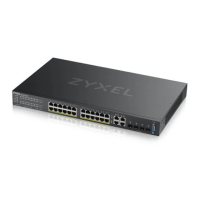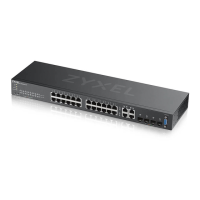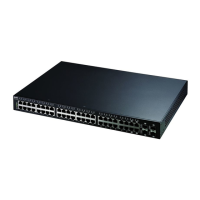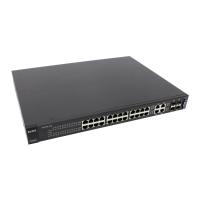Chapter 60 Port
GS2220 Series User’s Guide
468
The following table describes the labels in this screen.
Table 245 Port > PoE Setup > PoE Setup
LABEL DESC RIPTIO N
PoE Mode Select the power management mode you want the Switch to use.
• C la ssific a tio n – Select this if you want the Switch to reserve the maximum power for each PD
according to the PD’s power class and priority level. If the total power supply runs out, PDs
with lower priority do not get power to function. In this mode, the maximum power is reserved
based on what you configure in Ma x Po we r or the standard power limit for each class.
• C o nsumptio n – Select this if you want the Switch to supply the actual power that the PD
needs. The Switch also allocates power based on a port’s Ma x Po we r and the PD’s power
class and priority level. The Switch puts a limit on the maximum amount of power the PD can
request and use. In this mode, the default maximum power that can be delivered to the PD is
33 W (IEEE 802.3at Class 4) or 22 W (IEEE 802.3af Classes 0 to 3).
Port This is the port index number.
* Settings in this row apply to all ports.
Use this row only if you want to make some settings the same for all ports. Use this row first to set
the common settings and then make adjustments on a port-by-port basis.
Changes in this row are copied to all the ports as soon as you make them.
Active Select this to provide power to a PD connected to the port.
If left unchecked, the PD connected to the port cannot receive power from the Switch.
Priority When the total power requested by the PDs exceeds the total PoE power budget on the Switch,
you can set the PD priority to allow the Switch to provide power to ports with higher priority.
Select C ritic a l to give the highest PD priority on the port.
Select Hig h to set the Switch to assign the remaining power to the port after all critical priority
ports are served.
Select Lo w to set the Switch to assign the remaining power to the port after all critical and high
priority ports are served.
Power-Up Set how the Switch provides power to a connected PD at power-up.
802.3a f – the Switch follows the IEEE 802.3af Power over Ethernet standard to supply power to the
connected PDs during power-up.
Le g a c y – the Switch can provide power to the connected PDs that require high inrush currents at
power-up. Inrush current is the maximum, instantaneous input current drawn by the PD when first
turned on.
Pre - 802.3a t – the Switch initially offers power on the port according to the IEEE 802.3af standard,
and then switches to support the IEEE 802.3at standard within 75 milliseconds after a PD is
connected to the port. Select this option if the Switch is performing 2-event Layer-1 classification
(PoE+ hardware classification) or the connected PD is NOT performing Layer 2 power
classification using Link Layer Discovery Protocol (LLDP).
802.3a t – the Switch supports the IEEE 802.3at High Power over Ethernet standard and can supply
power of up to 30 W per Ethernet port. IEEE 802.3at is also known as PoE+ or PoE Plus. An IEEE
802.3at compatible device is referred to as Type 2. Power Class 4 (High Power) can only be used
by Type 2 devices. If the connected PD requires a Class 4 current when it is turned on, it will be
powered up in this mode.
Fo rc e -802.3a t – the Switch offers power of up to 33 W on the port without performing PoE
hardware classification. Select this option if the connected PD does not comply with any PoE
standard and requests power higher than a standard power limit.
Max Power
(mW)
Specify the maximum amount of power the PD could use from the Switch on this port. If you leave
this field blank, the Switch refers to the standard or default maximum power for each class.

